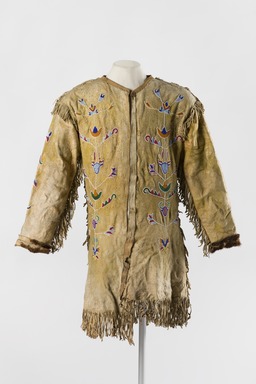Browse

| Accession # | 41.866 |
|---|---|
| Culture | Santee, Sioux |
| Culture | Crow |
| Culture | Red River Metis |
| Culture | Eastern, Sioux |
| Title | Man's Shirt Cut in European Style |
| Date | late 19th century |
| Medium | Buckskin, pigment, fur, glass beads, brass beads, iron beads, cotton cloth, pigment |
| Dimensions | at shoulders: 35 1/2 x 20 1/2 in. (90.2 x 52.1 cm) at hem: 35 1/2 x 53 3/16 in. (90.2 x 135.1 cm) |
| Credit Line | By exchange |
| Location | American Identities: Inventing American Landscape |
| Description | Man's hide shirt cut in a European style so it opens in front. It has beaded floral designs front and back and fringes along sleeves and the shirt's hem. |
Curatorial Remarks: About this Brooklyn Icon
The Brooklyn Museum is commemorating its 200th anniversary by spotlighting 200 standout objects in its encyclopedic collection.
Though historical accounts rarely offer the perspectives of Indigenous women, the artworks these women created serve as a lasting record of their vitality and innovation. Made by a woman likely from the Métis or Eastern Dakota tribal community, this shirt is adorned with intricate floral beadwork designs and fringe along the sleeves and hem. Cut from buckskin and with a European-style tailored fit, it departs from the loose-fitting shirts traditionally worn by Indigenous men from this region. The garment’s aesthetics reflect an interesting history of settler-Indigenous entanglement and the vital role Indigenous women played in navigating a world changed by colonization.
By making special garments with goods acquired through trade, such as silk thread and glass beads, women clothed community members, earned income to support their families, and transformed enduring artistic practices. In the 19th century, many Métis girls attended mission schools where white nuns taught them embroidery techniques and motifs, which students then indigenized to create the distinctive style seen on this shirt.
.***
Gallery Label
Cut in a European style and adorned with intricate floral beadwork, this shirt blends settler and Indigenous styles. Made by either a Red River Métis or an Eastern Dakota woman artist, the garment reflects a history of settler-Indigenous entanglement. The Métis, known as the “flower beadwork people,” possess mixed ancestry as a result of strategic alliances between Europeans and Cree and Anishinaabe peoples dating to the seventeenth-century fur trade. In the nineteenth century, many Métis girls attended mission schools where nuns taught them embroidery techniques and motifs that the students indigenized to create the distinctive style seen on this shirt.